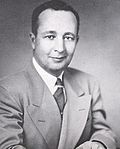| |||||||||||||||||
| |||||||||||||||||
| |||||||||||||||||
| Elections in Nebraska |
|---|
 |
The 1946 Nebraska lieutenant gubernatorial election was held on November 5, 1946. Incumbent Nebraska Lieutenant Governor Roy W. Johnson lost to Robert B. Crosby in the Republican primaries after the Nebraska Republican Pre-Primary Convention refused to endorse him for reelection. [1] Thus, the general election featured Robert B. Crosby as the Republican nominee who defeated Democratic nominee Robert J. Swanson. [2]

